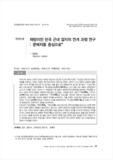

-
 * 본 문서는 배포용으로 복사 및 편집이 불가합니다.
* 본 문서는 배포용으로 복사 및 편집이 불가합니다.
미리보기
서지정보
· 발행기관 : 한국융합인문학회
· 수록지 정보 : 한국융합인문학 / 4권 / 3호
· 저자명 : 양윤모
목차
Ⅰ. 서 론
Ⅱ. 근대 잡지의 탄생
Ⅲ. 일본의 식민지배와 근대잡지의 명맥
Ⅳ. 문화정치와 동인지의 명멸
Ⅴ. 일본의 탄압 강화와 잡지의 위기
Ⅵ. 결 론
참고문헌초록
우리나라 최초의 근대적 잡지는 1908년 최남선이 창간한 소년(少年)지였다. 소년은 경영 및 편집이 체계를 갖추었고, 체제나 내용이 혁신적이었으며, 학회 및 단체의 기관지가 아닌 독립적 상태에서 불특 정한 다수의 독자를 대상으로 한 잡지라는 점을 들어 근대 종합잡지의 효시로 평가한다. 소년(少年) 폐간 이후 발간된 청춘(靑春)과 태서문예신보(泰西文藝新報)는 각각 대중 교양 계몽지, 문예전문지 로서 큰 의의를 지닌다. 1919년 3・1 독립운동 이후 일본이 문화정치(文化政治)를 표방하는 유화책을 쓰 면서 신문과 잡지의 발행이 허용되어 동아일보, 조선일보, 시대일보 등의 신문과 개벽(開闢), 조선지 광(朝鮮之光) 등의 잡지가 발행되었다. 개벽(開闢)은 천도교를 기반으로 하였지만 천도교뿐 아니라 민족주의, 사회주의를 아우르는 통합적 면모를 보여주었고, 이를 경계한 식민당국의 탄압으로 폐간 당 하였다. 조선지광(朝鮮之光)은 사회주의 사상을 표방하였으며, 조선문단(朝鮮文壇)은 이광수가 주재 한 문예잡지로 민족주의적 경향을 보여주었다. 1920년대 창조(創造), 폐허(廢墟), 백조(白潮) 등의 동인지는 문학 동인들을 중심으로 다양한 문학 관과 다양한 경향의 작품들이 발표되었다. 동인지는 전문적 문예지의 탄생을 의미하며 문학작품을 발표 할 수 있는 지면의 확대와 더불어 문학작품이 예술 장르로서 독립적 위치를 차지하게 되었다는 의의를 지닌다. 순문예 월간지로 발행된 문장(文章)은 일제 말기 암흑기의 문단을 밝히는 등불 같은 존재였지 만 조선어 사용을 금지하는 등 일본 식민지 당국의 민족혼 말살 정책과 같은 탄압을 견디지 못하고 자 진 폐간함으로써 민족적 자존심을 지켰지만 해방이 될 때까지 우리 문학의 명맥이 일시 단절되었다는 점에서 아쉬움을 남겼다.영어초록
The So-nyeon (The Boy), published on November 1st, 1908 by Choi Namseon, was the first modern literature magazine in Korea. The So-nyeon is considered as the first all-round magazine for the following reason: not only were its editing system and content innovative but it also targeted large unspecific readers not as a magazine published by academic circles or public institutes but as an independent one.
After The So-nyeon, The Cheongchun (The Young) and The Taeseomunyeshinbo (The Newspaper of European Literature) were published in Korea. The two had great significance, the former as a culture enlightenment magazine and the latter as a specialized magazine of literature.
After the Independent Movement on March 1st, 1919, Japanese colonial officials allowed publication of newspapers and magazines in Korea. As a result, newspapers like Dong-a, Choseon, etc. and magazines like The Gaebyeok (The Beginning of the World), The Choseonjikwang (The Light of Choseon) started to appear.
The Gaebyeok, though based on Cheondoism, showed integrated aspects by covering not only Cheondoism but nationalism and socialism as well. The Japanese colonial officials felt threatened by its resistant power, which resulted in them forcing the discontinuance of the magazine.
Many literary coteries magazines were published in the 1920s. Some of them include The Changjo (The Creation), The Pyeheo (The Ruins), The Baekcho (The White tide), etc. Their emergence meant the birth of many specialized literature magazines. The Munjang (The Sentence), published near the end of the Japanese Occupation era, was a pure literature magazine. Its presence was like a lantern lightening up the literary circle during the dark colonial period. The Japanese colonial officials forbade Koreans from using Korean.
The Munjang, unable to bear suppression from Japanese officials, eventually had no choice but to close down, leaving the line of Korean literature discontinued until Korea regained its independence.참고자료
· 없음태그
-
자료후기
-
자주묻는질문의 답변을 확인해 주세요

꼭 알아주세요
-
본 학술논문은 (주)코리아스칼라와 각 학회간에 저작권계약이 체결된 것으로 AgentSoft가 제공 하고 있습니다.
본 저작물을 불법적으로 이용시는 법적인 제재가 가해질 수 있습니다. -
해피캠퍼스는 구매자와 판매자 모두가 만족하는 서비스가 되도록 노력하고 있으며, 아래의 4가지 자료환불 조건을 꼭 확인해주시기 바랍니다.
파일오류 중복자료 저작권 없음 설명과 실제 내용 불일치 파일의 다운로드가 제대로 되지 않거나 파일형식에 맞는 프로그램으로 정상 작동하지 않는 경우 다른 자료와 70% 이상 내용이 일치하는 경우 (중복임을 확인할 수 있는 근거 필요함) 인터넷의 다른 사이트, 연구기관, 학교, 서적 등의 자료를 도용한 경우 자료의 설명과 실제 자료의 내용이 일치하지 않는 경우
“한국융합인문학”의 다른 논문도 확인해 보세요!
-
내재적 분석을 통한 소설의 인물 관계 연구 : 한설야 『塔』서 주인공의 정체성 형성을 중심으로 18 페이지
이 글은 한설야의 소설 『탑』이 지닌 문학사적 의미를 인물 분석을 통해 드러내고자 기획되었다. 카프 맹 원인 한설야가 현실을 버리고 구한말 어린 소년을 내세워 글쓰기를 한 이유를 작품의 내적 상황에서 밝 히고자 하였다. 내재적 분석을 시도한 결과 『탑』의 중심 코드인 주인공 우길은 여성 인물 계섬과의 관계를 통하여 신분제의 해체를 겪고, 아버지 박진사와의 .. -
한국어 양보관계 연결어미의 통사적 특징에 대한 연구 23 페이지
한국어 접속문에서 두 절을 연결시켜 주는 중요한 요소는 연결어미이며, 연결어미를 통해서 두 절의 상 호관계가 드러난다. 반면에 중국어의 접속문은 주로 관련 사어를 이용하여 두 절을 연결한다. 중국어의 관련 사어는 연사와 관련부사의 결합형식으로 한국어의 연결어미와 같은 기능을 담당한다. 이러한 언어 적 특성의 차이로 인해 중국인 학습자가 한국어를 배울 때에 .. -
전통 문화마을의 플랫폼전략 사례 연구 : 전주 한옥마을을 중심으로 21 페이지
이 논문은 최근 경영학에서 많이 연구되고 있는 플랫폼전략에 근거하여 전통 문화마을의 생태계를 연구 하고 있다. 전통 문화마을이 국내 관광의 중요한 명소로서 개발되고 있는데, 공진화의 플랫폼전략 관점 에서 분석되고 발전될 필요가 있다. 문화생태계에 대한 플랫폼전략은 관광산업에서 매우 유용할 것이다. 이 논문은 국내 한옥마을 중 전통 문화의 콘텐츠가 잘 활용되..
문서 초안을 생성해주는 EasyAI

